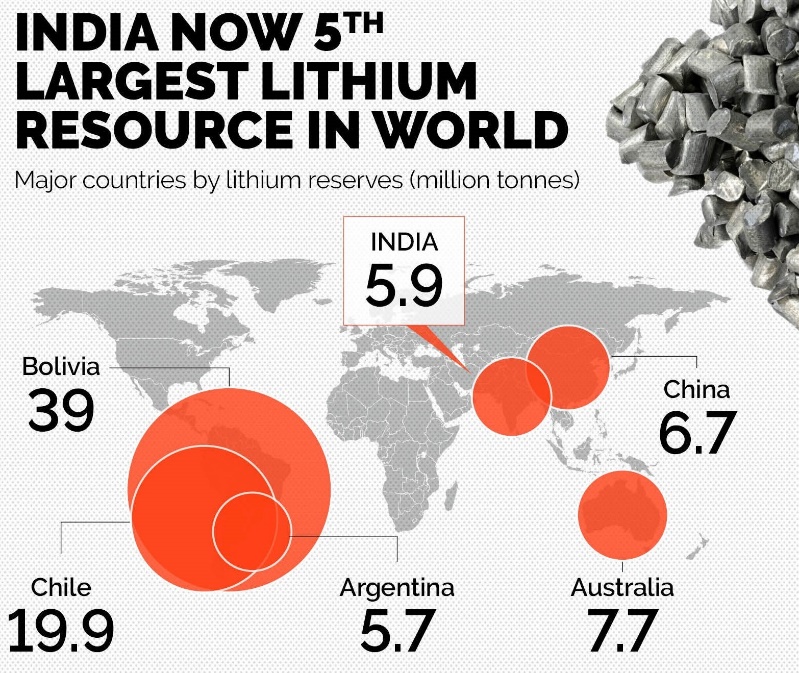Lithium reserves in India
2023 MAY 11
Mains >
Geography > Resource geography > Resource geography
IN NEWS:
- The Geological Survey of India (GSI) termed media reports saying large lithium reserves being identified in Rajasthan's Degana (Nagaur) as "baseless".
- The Union Government in February 2023 said that 5.9 million tonnes of lithium reserves had been found for the first time in the country in Jammu and Kashmir’s Reasi district.
LITHIUM:
- Lithium (Li) is a grey, shiny, highly reactive non-ferrous metal. It is the lightest and the least dense of all metals.
- lithium is largely used for making rechargeable batteries. It also used to manufacture heat-resistant glass and ceramics, industrial greases, and treatment of mood disorders like bipolar disorder and depression.
- Lithium is currently extracted from two main sources:
- Hard rock mines
- As brine from salt flats and lakes, from where it is recovered using evaporation tanks
- The world's largest Lithium resources are in Bolivia. Together with Argentina and Chile, Bolivia forms the ‘Lithium triangle’, which contain roughly half the world’s known Li. Other major reserves are in China and Australia.
- However, owing to its production capabilities, China, which has reserves of 5.1 million tonnes of Lithium, has a monopoly in the global lithium market.

SIGNIFICANCE OF INDIA’S LITHIUM RESERVES:
- “White gold”:
- Since lithium is necessary for every rechargeable battery-powered gadget, it is considered as a new age energy mineral. It is likely to be as important as oil and gas in the near future and is often called ‘white gold’.
- Growing demand:
- According to the World Bank report, by 2050, the global demand for Lithium metal will increase by 500%. In this scenario, getting immense reserves of Lithium is extremely for the country's economy.
- Resource sovereignty:
- India imports nearly 54% of its Lithium from China. This high level of dependence on China in the light of strained bilateral relations is perceived to be an energy security risk for India.
- Geostrategic significance:
- Covid pandemic exposed the limitations of global supply chain and countries are increasingly investing in the China+1 strategy. If the perceived size of the mineral reserves in J&K is borne out by further exploration, India could jump ahead of China in the global Li supply chain.
- China+1 strategy: https://www.ilearncana.com/details/China-%2B-1-strategy/4039
- Support transition to net-zero carbon energy systems:
- The reserves could help advance the Indian government’s ambitious plan of 30% EV penetration in private cars, 70% for commercial vehicles, and 80% for two and three-wheelers by 2030 for the automobile industry. They will strengthen India’s National Mission on Transformative Mobility and Storage as well.
- Industrial development:
- Currently, 70% of India’s Li-ion cell requirement are met through imports from China and Hong Kong. The lithium reserves in J&K and Rajasthan could boost the domestic battery-manufacturing industry.
- Reduce cost of batteries:
- Lithium accounts for 15% of a battery’s cost. The cost of batteries could drop by 5 percent if lithium can be purchased from the Indian reserve for 2/3rd the cost of the imported material.
CHALLENGES:
- Environmental issues:
- Extracting Li from hard rock mines, similar to what is proposed in J&K, entails open-pit-mining followed by roasting the ore using fossil fuels. Industry estimates suggest that this process consumes 170 cubic metres of water and releases 15 tonnes of CO2 for every tonne of Li extracted.
- Social concerns:
- The livelihood of communities, who in many cases are indigenous to the area and hold traditional or communal rights to land, are affected by mining operations. If the local populace is not meaningfully engaged in the impending Li extraction project, the resulting tension could introduce new frontiers of socio-environmental conflict.
- Security concerns:
- Although Reasi is in the relatively more stable Jammu region, the Union territory of J&K has been the site of historical cross-border tensions between India and Pakistan, domestic insurgency, and terrorism.
- Ineffectiveness of ‘District Mineral Foundation’ (DMF):
- The DMFs, designed to work for the interest and benefit of people and areas affected by mining-related operations, have become sites of centralised bureaucratic control, without meaningful public participation or accountability.
- For example, a CAG audit in May 2022 noted that the district collectors of Bokaro, Dhanbad, and Ranchi incurred an expense of Rs. 1568.04 crore from DMF funds, without identifying the areas affected by mining or a list of affected people. Ironically, the auditors were denied access to documents related to the functioning of the State-Level Monitoring Committee.
- https://www.ilearncana.com/details/District-Mineral-Foundations-DMF/2469
- Weak environmental impact assessment framework:
- The existing EIA framework is plagued by the lack of efficient monitoring and verification process. There are no standardized systems for appointment of consultants, scrutiny of reports or punishment for violation of the ToR. Also, the draft EIA Notification 2020 seeks to dilute several provisions of the 2006 notification.
- Read more here: https://www.ilearncana.com/details/Environmental-Impact-Assessment-EIA/2901
- Technological limitations:
- At present, India does not have lithium extraction technologies. Also, turning lithium ore into purer lithium carbonate or lithium hydroxide needed for batteries is an expensive and capital-intensive process. To overcome this, significant investments and involvement of private sector is necessary.
CONCLUSION:
Discovering lithium reserves is just the first step. The geostrategic importance of Li exploration and extraction makes it even more important that the exploration and extraction of resources should be done in the public interest, and must preempt any serious environmental and social problems.
To make India self-reliant and a global EV manufacturing destination, the industry requires well-rounded support in the form of ease of capital inflow for battery and EV manufacturing and a focused approach towards battery recycling.
Equally importantly, the most effective use of Li reserves should be for the most important parts of the renewable-energy transition, which would also aid the goals of addressing energy poverty and sustainable development.
PRACTICE QUESTION:
Q. The discovery of lithium reserves in India could have significant implications for the country’s energy security and economic growth. Discuss.
